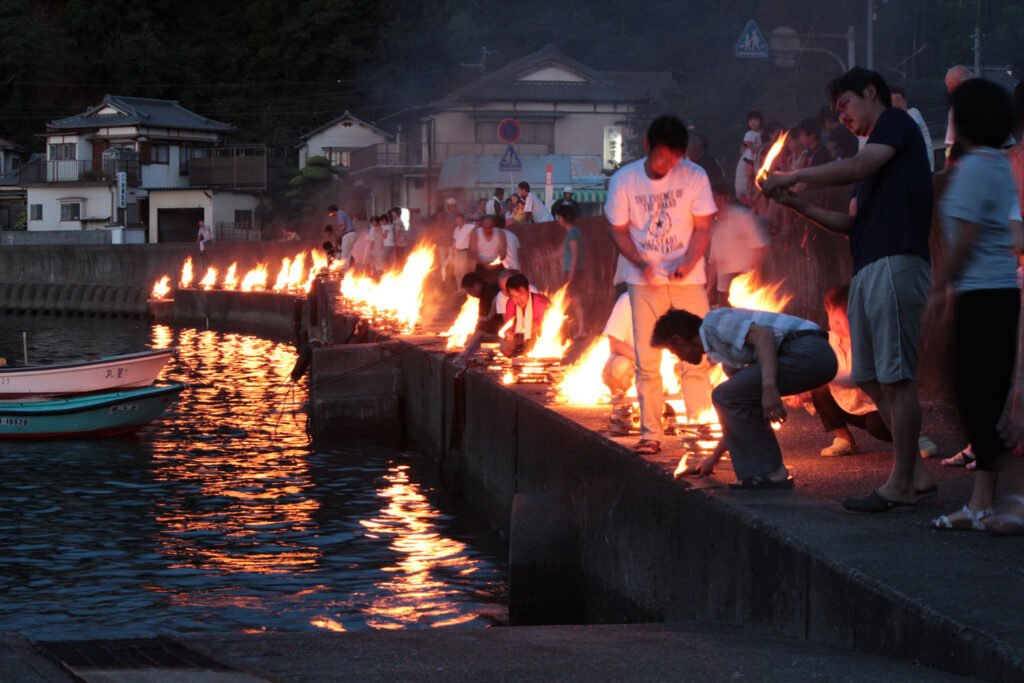When you join the Obon Festival, you get a chance to experience a celebration steeped in centuries of history. This Japanese tradition is deeply rooted in honoring ancestors and strengthening family ties.
Picture this: vibrant Bon Odori dancing fills the streets as people move in sync with traditional rhythms. Paper lanterns float gracefully on water, lighting up the night with a warm, ethereal glow. Fire rituals crackle and spark, symbolizing the guiding lights for ancestral spirits returning home.
But Obon is more than its mesmerizing activities. It’s a bridge connecting the past with the present, keeping cultural heritage alive and thriving.
Each region adds its own twist to this festival, creating a rich tapestry of celebrations across Japan.
What Is Obon?
Obon is a time-honored festival dedicated to respecting the spirits of one’s ancestors.
It is a traditional Buddhist festival celebrated in Japan, typically around August 10 to 17-18. It’s a time for families to visit their relatives and ancestors’ graves, pay their respects, and honor the spirits of the deceased.
The Historical Evolution of Obon: From Its Origins to Today
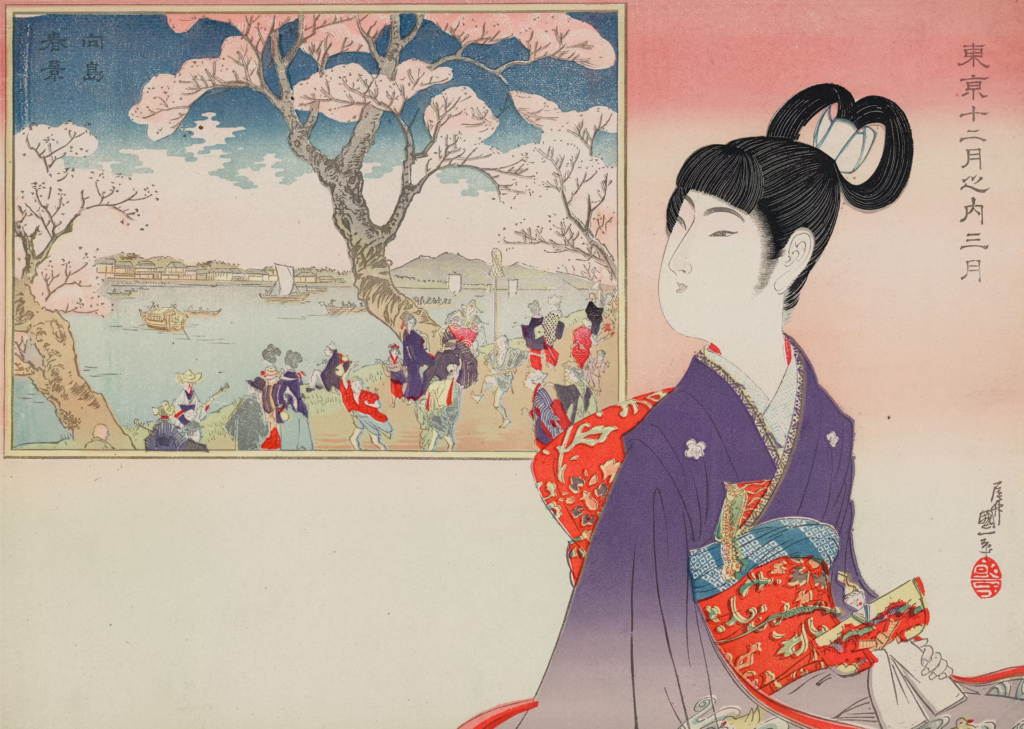
While rooted in ancient Buddhist traditions, the Obon Festival has evolved over centuries to become one of Japan’s most cherished cultural celebrations.
The story behind Obon traces back to a disciple of Buddha named Maha Maudgalyayana (Mokuren).
According to legend, Maudgalyayana’s mother was suffering in the spirit world. Worried, he sought Buddha’s advice.
Buddha advised him to make offerings to Buddhist monks. Maudgalyayana followed this counsel, and as a result, his mother was released from her suffering.
This act of filial piety and compassion is at the heart of Obon celebrations.
During the festival, families prepare offerings which often include foods like cucumber and eggplant. These foods are sometimes crafted into small animals — like a cow or horse — using chopsticks for legs.
The cow, representing slow travel, symbolizes a peaceful journey for spirits to return. Bonfires are lit, guiding the spirits back to the spirit world at the end of their visit.
Once you take a closer look at the historical evolution of Obon, you see a transformation influenced by various cultural and social changes.
Initially, it was a solemn event focused on spiritual practices and rituals. Over time, however, it started to incorporate local customs and became more community-centered.
By the Edo period, Obon had taken on many of the vibrant festival traditions we see today, including dancing, lantern lighting, and family reunions.
In modern times, Obon is celebrated with a blend of reverence and festivity. People honor their ancestors through dances like Bon Odori, enjoy fireworks, and partake in communal feasts. The festival’s enduring appeal lies in its ability to adapt while preserving its core spiritual message.
Cultural Significance of Obon
The Obon Festival holds profound importance in Japan, blending spiritual reverence with community celebration. It’s a time when families honor their ancestors’ spirits, believing they return to visit the living during this period.
The Obon Festival isn’t just about spiritual practices; it’s also a vibrant celebration that brings communities together.
People participate in traditional dances performed to welcome and entertain the spirits. Lanterns are lit and floated on rivers to guide the spirits back to the afterlife, creating a beautiful and serene spectacle.
The festival serves as a reminder of the values of gratitude, respect, and community.
When and How Long Is Obon Celebrated?
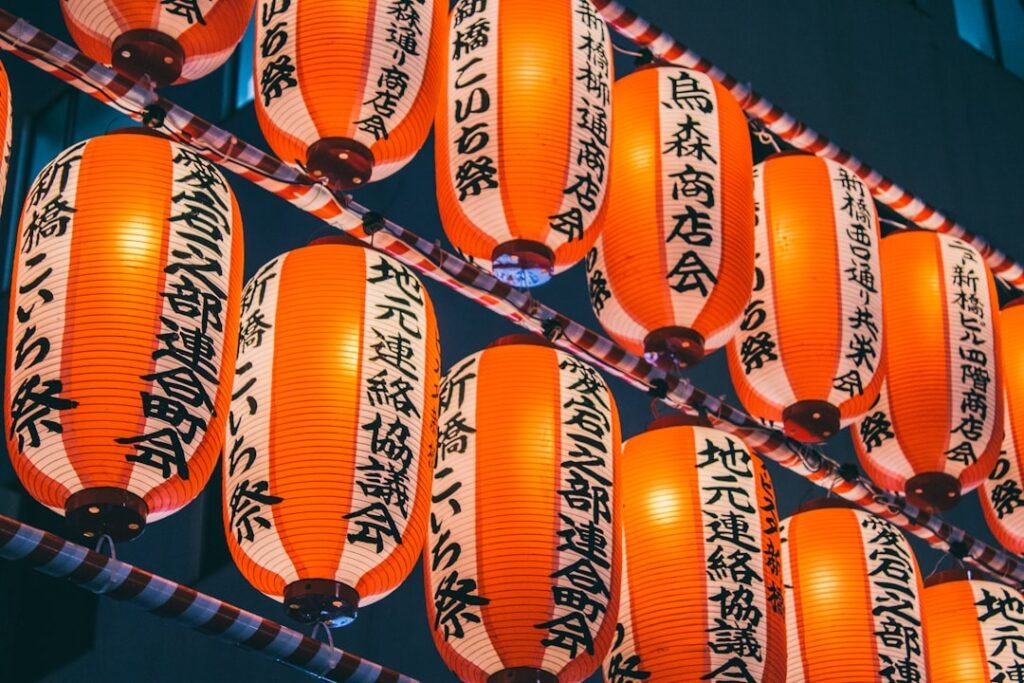
Obon lights up different towns at different times. Depending on where you are in Japan, you’ll see the vibrant festivities either in July or August.
Why the difference? It’s all about history.
Long ago, Japan followed the lunar calendar. However, with the adoption of the modern Gregorian calendar, things changed. Some regions stuck to the old ways, while others embraced the new.
Each area has its unique flair, honoring ancestors in a heartfelt yet festive way.
One of the best places to experience Obon is in Gifu Prefecture, where festivals in Japan are known for their vibrancy. Communities come together to light fires and take part in various rituals that connect them with their ancestors.
For many, this period is one of the busiest times of the year as they flock to their hometowns.
To a foreigner, participating in Obon can be a great experience. It offers an enriching view into how Japanese families honor their past while living in the present.
The spiritual realm during Obon feels vividly alive, making it an unforgettable event that bridges the gap between worlds.
Obon Dates Across Japan
Obon is celebrated at different times across Japan, typically lasting for three days. However, it doesn’t happen all at once everywhere. Obon’s dates vary a lot due to regional differences and historical calendar systems.
Traditionally, Obon was observed according to the lunar calendar, aligning with the 15th day of the seventh month. This often placed the festival in what’s now August on the solar calendar.
Yet, as Japan moved to the Gregorian calendar, the dates and length have seen variations.
- In many areas, including Tokyo, Obon is celebrated around mid-August, from the 13th to the 16th. This period is known as ‘Hachigatsu Bon’ or August Bon.
- In other regions like Kyoto, you’ll find ‘Kyū Bon,’ which follows the old lunar calendar and usually begins in mid-July.
- There’s also ‘Shichigatsu Bon,’ which is celebrated in July in some parts of the country.
During the festival, people participate in various customs, such as cleaning family graves and lighting lanterns to guide the spirits back home.
The duration of the festival has also changed. While traditionally a three-day event, modern observance can extend to a week, allowing more flexibility for families to reunite and honor their ancestors.
What Are the Essential Elements of the Obon Festival
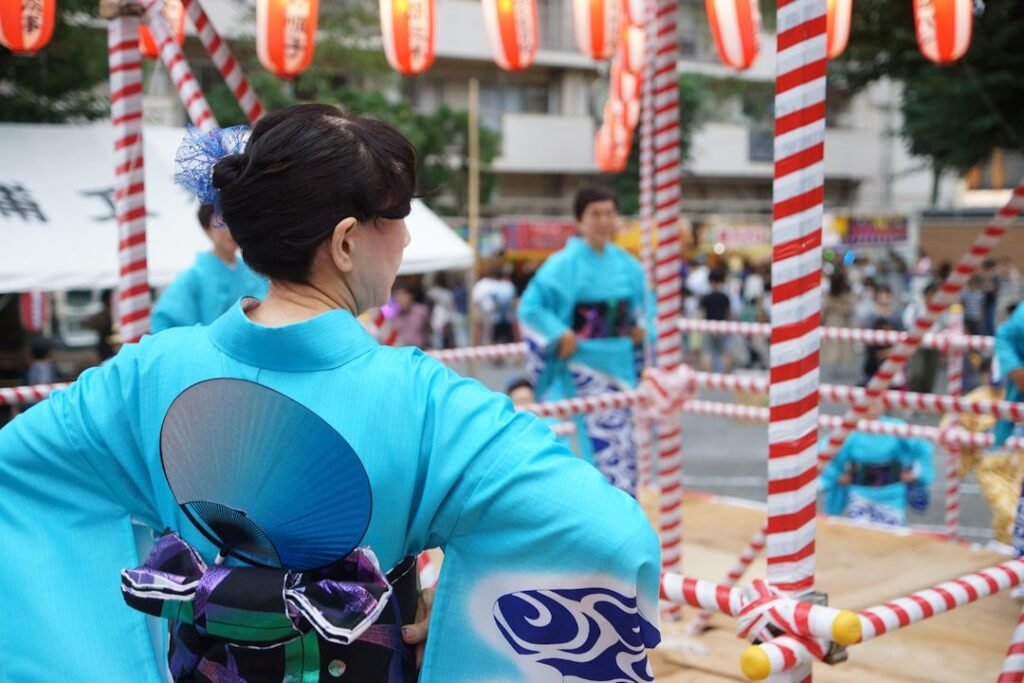
When you explore the Obon, you’ll encounter a tapestry of various activities that bring the celebration to life.
Each aspect of the festival holds deep cultural significance, from the rhythmic Bon Odori dances to the serene Toro Nagashi floating lanterns.
Bon Odori: The Joyful Dance of Spirits
Central to the Obon Festival is Bon Odori, a vibrant dance that brings communities together and celebrates the spirits of ancestors.
This joyful celebration, practiced for centuries, is an offering of respect and love to those who have passed on.
Bon Odori is typically performed in a circle around a raised platform called a yagura. The dance steps and music can vary by region, but the essence remains the same: honoring the spirits and fostering community spirit.
Participants often wear yukata, a casual summer kimono.
Here’s a quick overview of Bon Odori’s key elements:
| Element | Description |
| Dance Steps | Simple, repetitive movements anyone can follow |
| Music | Traditional tunes, sometimes accompanied by taiko drums |
| Attire | Yukata and other traditional garments |
| Yagura | Central platform where musicians and dancers gather |
Toro Nagashi: The Magic of Floating Lanterns
Floating lanterns, known as Toro Nagashi, create a mesmerizing spectacle that symbolizes the guiding of ancestors’ spirits back to the otherworld.
As night falls, you’ll witness rivers and lakes illuminated by a sea of gently floating lanterns, each one carrying the hopes, prayers, and memories of families. It’s a visual feast, but also a profound cultural celebration rooted in Japanese tradition.
The sight of hundreds of glowing lanterns drifting silently is both serene and powerful, evoking a deep sense of connection with those who’ve passed.
Toro Nagashi is an act that provides both solace and a sense of freedom, as you acknowledge the continuous cycle of life and death. Through this practice, the Obon Festival becomes a poignant reminder of the enduring presence of loved ones in our lives.
Mukae-bi and Okuri-bi: Fire Rituals of Welcome and Farewell
Mukae-bi and Okuri-bi are fire rituals that bookend the Obon Festival, welcoming and bidding farewell to the spirits of ancestors. These ancient customs hold deep significance in Japanese culture, embodying the essence of familial respect and spiritual connection.
- Mukae-bi, the welcome fire, is typically lit at the beginning of Obon to guide the spirits of loved ones back to the world of the living. You’ll often see families lighting small flames or lanterns at their doorsteps, creating a warm, inviting pathway for their ancestors.
- As the festival concludes, Okuri-bi, the farewell fire, takes place. This ritual is just as important, ensuring the spirits safely return to the afterlife. The flickering flames symbolize the ephemeral nature of life while also reinforcing the enduring bonds between the living and the departed.
Participating in Mukae-bi and Okuri-bi connects you to generations past and future, offering a moment to reflect on the transient yet eternal aspects of existence.
Honoring Ancestors: Grave Visitations and Remembrances
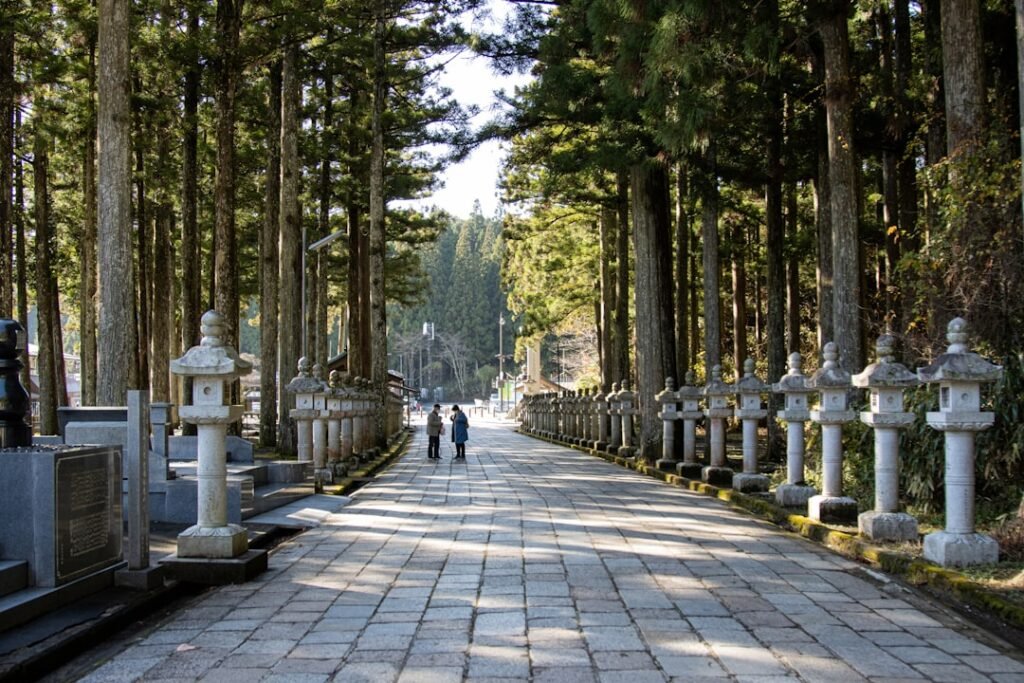
Visiting and cleaning the graves of ancestors is a cornerstone of the Obon Festival. During this time, you’ll find families gathering at cemeteries, meticulously tending to their ancestors’ places of rest.
By cleaning the gravestones, offering flowers, and lighting incense, they preserve the memory of their ancestors and express gratitude for their lives.
Additionally, these grave visitations offer a moment of introspection, allowing for a moment of reflection on our own lives and the legacy we leave behind.
How to Prepare for Obon: Rituals and Traditions
To prepare for Obon, you’ll need to refresh the Butsudan, set up the Shoryodana, and gather meaningful offerings.
Each step has deep cultural significance and helps honor the spirits of your ancestors.
Spruce Up the Butsudan

One of the key preparations for Obon involves sprucing up the butsudan, a household Buddhist altar, to honor and welcome the spirits of ancestors.
To start, you’ll want to clean the butsudan thoroughly, removing dust and clutter. This act isn’t just about aesthetics; it’s a way to show respect and care for the spirits you’re inviting.
Next, consider adding fresh flowers and seasonal fruits to the altar. These offerings symbolize purity and gratitude.
Incense sticks, known as senko, are also essential. Their fragrant smoke is believed to guide spirits back to the world of the living.
Lighting candles further enhances this connection, creating a warm, inviting atmosphere.
Don’t forget to place a photograph or a memento of your ancestors on the butsudan. This personal touch makes the ritual more intimate and meaningful.
Set Up the Shoryodana
Setting up the shoryodana is an essential ritual for preparing for the Obon festival. This practice allows you to create a sacred space to guide the spirits of your ancestors back home.
To set up the shoryodana properly, you need to:
- Select a suitable location. Most people go for a place near the butsudan, where the shoryodana can be easily accessed and seen by all family members.
- Clean the area. Tidiness is important. Cleaning the space thoroughly shows respect to the ancestral spirits.
- Arrange offerings. Placing seasonal fruits, flowers, and other symbolic items on the shelf shows appreciation to your ancestors.
- Light candles and incense. These lights help guide the spirits and create a serene atmosphere.
- Include a Buddha image. Adding a small Buddha statue or image reinforces the spiritual significance of the shelf.
Make Meaningful Offerings
During the Obon festival, making thoughtful offerings is a heartfelt way to honor and connect with your ancestors.
One of the most significant practices is preparing food for the spirits, as it is believed that ancestors return to enjoy the taste of their favorite dishes.
| Offering Type | Purpose | Examples |
| Food | Nourish spirits | Seasonal fruits, rice, sweets |
| Lanterns | Guide spirits | Paper lanterns, candles |
| Flowers | Show respect | Chrysanthemums, lilies |
| Incense | Purify and honor | Sandalwood, frankincense |
| Obon Dances | Celebrate and welcome spirits | Traditional Bon Odori |
When preparing food offerings, choose items that your ancestors loved. Seasonal fruits, rice, and sweets are all great options chosen by many Japanese people.
The Diverse Faces of Obon: Regional Variations

Obon Festival’s rich tapestry is woven with distinct regional traditions that highlight Japan’s cultural diversity. From region to region, you’ll find unique customs, food variations, bon dancing styles, and timing differences that make each celebration special.
- The length of Obon can vary greatly. In Shikoku, the festival is extended by the Shikoku Pilgrimage, where the faithful visit 88 temples over several weeks.
- Bon dancing (Bon Odori) also varies widely. In Tokushima Prefecture, the Awa Odori festival features lively, spirited movements, while in Yamagata Prefecture, Hanagasa Odori has dancers with flower-adorned hats performing more traditional steps.
- Food is another area where regional diversity shines. In Hiroshima, families gather to enjoy ‘Okonomiyaki,’ a savory pancake loaded with various ingredients. In the Kansai region, ‘Zaru Soba,’ chilled buckwheat noodles served on bamboo trays, is a common Obon delicacy.
- Even the Okuribi fires, meant to guide spirits back, aren’t uniform across the country. In Kyoto, fires are shaped into intricate designs like boats and animals, while in Nara, they form patterns inspired by ancient Buddhist symbols.
Obon’s Economic Impact: The Festival’s Influence on Local and National Markets
Obon lights up the economy like fireworks in the night sky. Both local and national markets thrive during this time. Families travel far and wide to visit ancestral homes, filling trains and buses. As they move, they spend — big time.
Small shops come alive, selling lanterns and ceremonial items. Big stores don’t miss out on the celebrations either, as they offer traditional clothes and gifts. Everyone gets a piece of the pie.
Hotels get booked solid. Restaurants buzz with energy. Inns welcome guests from near and far, all eager to dive into Japanese traditions. Local eateries can’t keep up with the demand as festival-goers feast on delicious foods and drinks.
Nationally, Obon turns people into tourists in their own country. They explore new regions, fill out travel agency rosters, and book tours. Cultural sites see record numbers of visitors.
The money spent during Obon is no joke. It gives Japan’s GDP a noticeable lift. This single festival shows just how powerful tradition can be for an economy.
What Are the Traditional Foods of Obon?
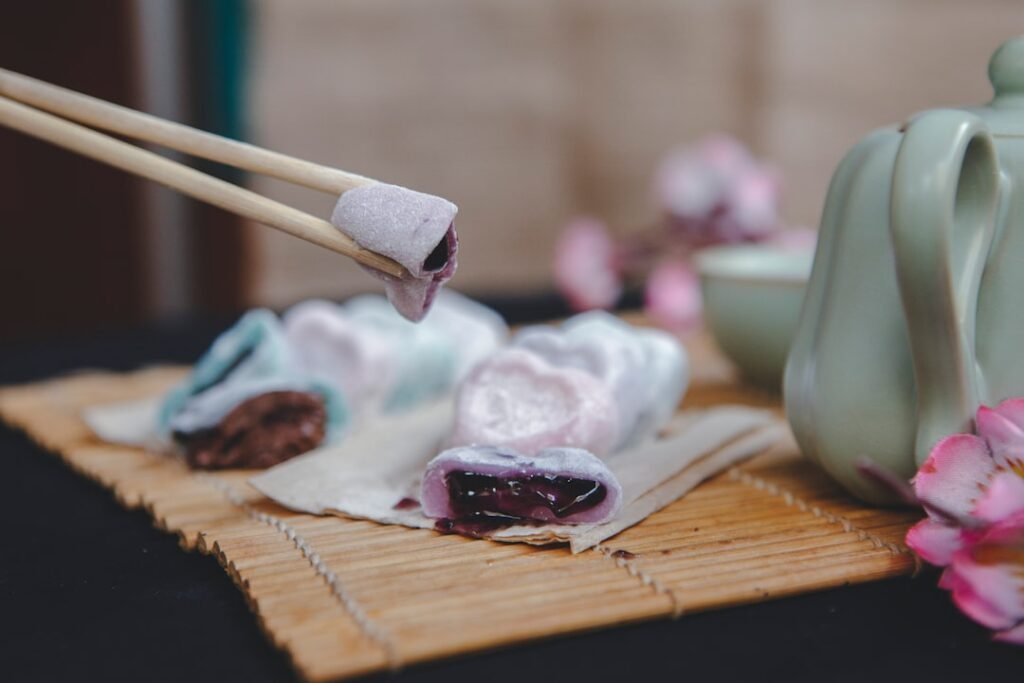
When participating in the Obon festival, you’ll find an array of traditional foods that hold deep cultural significance during the Obon festival. These delicacies aren’t only meant for nourishment but also serve as offerings to honor ancestors.
During Obon, you’ll see a particular emphasis on simplicity and symbolism in the food. Some of the dishes you might encounter include:
- Mochi rice cakes are often shaped to represent different elements of nature and are a common offering.
- Eggplant and cucumber are transformed into symbolic animals using toothpicks, representing the spirit’s journey.
- Somen noodles are often enjoyed chilled, symbolizing the invigorating coolness of summer.
- Osekihan, a form of red bean rice, is considered very popular and is a staple during many Japanese celebrations, including Obon.
- Botamochi (sweet rice balls), covered in red bean paste, represent the connection between the living and the spirits of ancestors.
Visiting Japan During Obon: A Traveler’s Guide
When planning your trip to Japan during Obon, you’ll want to know the top destinations to truly experience the festival’s magic.
Understanding what to expect and how to navigate the cultural nuances can make your visit both enriching and respectful.
Top Destinations to Experience the Magic of Obon
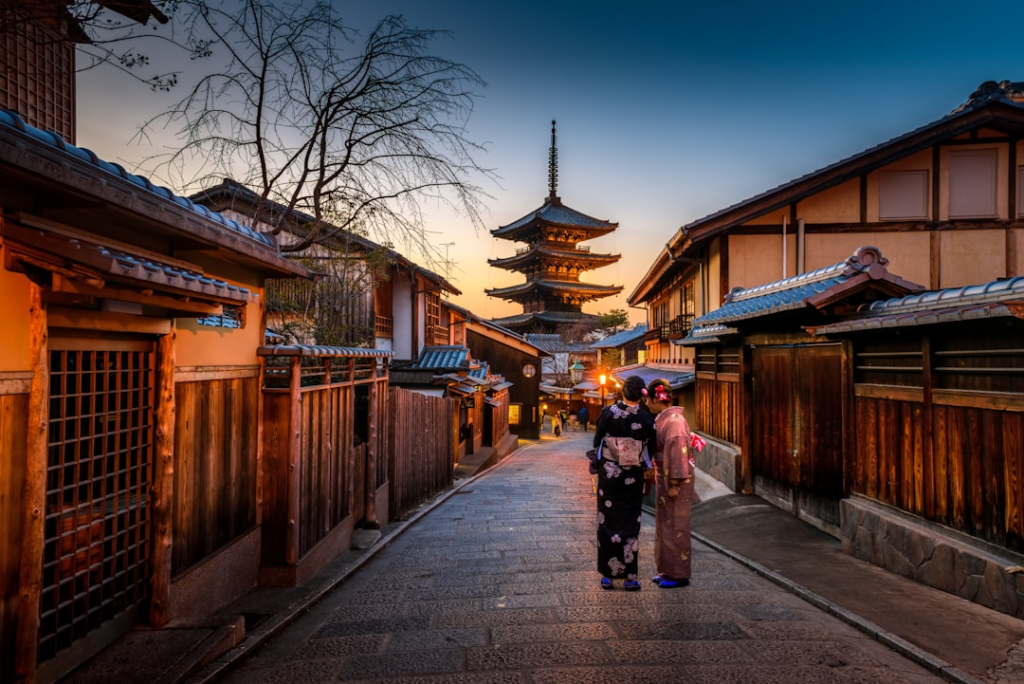
To truly immerse yourself in the spirit of Obon, consider visiting Kyoto, where traditional dances and lantern festivals bring the city to life.
Kyoto is renowned for its rich Japanese culture, and during the Obon festival, the city becomes a vibrant showcase of centuries-old traditions.
You can witness mesmerizing odori (folk dances) performed by locals in beautiful yukatas, and the tranquil sight of floating lanterns on the Kamogawa River.
Tokyo, Japan’s bustling capital, offers a contrasting yet equally enchanting Obon experience. Here, you can enjoy modern interpretations of the festival alongside traditional practices. Visit temples and shrines where the air is filled with the sounds of taiko drums and the scent of incense.
To make the most of your Obon journey, consider these top destinations:
- When in Nagasaki, don’t miss the Shoro Nagashi, a unique lantern-floating ceremony.
- In Osaka, it’s recommended that you visit the Tennoji Temple, known for its grand Bon Odori event.
- Nara is known for the traditional Obon celebrations in the historic town of Ikaruga.
What to Expect: Practical Advice for Visitors Attending Obon

As you prepare to experience the magic of Obon in Japan, it’s important to know what to expect and how to make the most of your visit.
During this time, you’ll see lanterns hung outside homes to guide the spirits back. Expect bustling activity as families make food offerings at altars to honor their ancestors.
Local markets and temples are filled with people buying special foods and ceremonial items. To also participate in that, consider learning some basic Japanese phrases. This can make your interactions more fulfilling and show respect for the traditions you’re witnessing.
Accommodations can fill up quickly during Obon, so book early. Whether you choose a traditional ryokan or a modern hotel, plan ahead to secure a comfortable stay.
Navigating the festival can be overwhelming, but it’s also an unparalleled cultural experience.
How to Respectfully Participate in Obon Traditions

Participating in Obon traditions respectfully requires understanding and observing a few key customs.
Here are some tips to help you:
- Wear traditional attire, like a yukata or conservative clothing. This shows respect for the event’s solemnity and Japanese tradition.
- Participate in activities such as Bon Odori (folk dancing) and Toro Nagashi (floating lanterns) with sincerity. These rituals are integral to Obon traditions.
- When visiting temples or gravesites, behave quietly and respectfully. Offer incense and prayers if appropriate.
- Knowing simple phrases like ‘Arigatou’ (thank you) can go a long way. It shows your effort to connect with the local culture.
- Pay attention to how locals act and follow their lead. It will help you participate respectfully and avoid misunderstandings.
Conclusion
Experiencing the Obon Festival allows you to immerse yourself in a celebration that bridges the past and the present, connecting you to Japan’s rich cultural heritage.
Whether you’re participating in traditional dances, witnessing the serene floating lanterns, or honoring ancestors through ancient rituals, Obon is a profound reminder of the enduring importance of family, respect, and community.
Frequently Asked Questions (FAQs)
Are businesses and services closed during Obon?
Most businesses, including banks, grocery stores, and post offices, remain open during the Obon period. However, small family-owned shops and local businesses may close as owners and employees participate in the festivities and traditional family gatherings.
Tourist attractions such as temples, shrines, and museums usually stay open and might even extend their hours to accommodate the influx of visitors. That being said, it’s always a good idea to check in advance if you have any specific places you intend to visit.
In general, major cities might not see significant disruption in services, but rural areas could have more widespread closures.
How do children participate in the Obon Festival?
Children can participate in the Obon Festival in several heartwarming ways. For example, they might join in Bon Odori dances, which are made accessible and enjoyable for participants of all ages.
Other than that, they may help elders in their families prepare offerings and snacks for the festivals, learning about the traditions and the importance of honoring the dead.
Many schools and community centers also organize educational programs and activities to teach children about the cultural and spiritual significance of Obon.
Are there any specific taboos or things to avoid during Obon?
During Obon, visitors should be mindful of several cultural taboos to ensure respect for the traditions:
- Avoid wearing black, as it is reserved for funerals and mourning. Instead, choose festive clothing or traditional attire like yukatas.
- Be respectful and quiet during rituals and at gravesites. Loud, disruptive behavior or frivolous conduct is considered disrespectful.
- Do not point at graves or shrines, as it is impolite. Additionally, avoid touching religious artifacts unless invited to do so.
- When making offerings at temples or altars, follow local customs and place them gently, showing respect and reverence.
What are some popular souvenirs or keepsakes to take home from the Obon Festival?
Souvenirs from the Obon Festival offer beautiful mementos of this deeply cultural experience:
- Traditional Japanese fans, often decorated with festival-themed prints, are both practical and ornamental.
- Miniature versions of the lanterns used in Toro Nagashi can be a poignant keepsake.
- Sweets and snacks that are only available during the festival period, such as special mochi.
- Protective amulets from temples, each designed to bring good fortune, health, or success to the bearer.
- Hand-made crafts and toys that reflect the cultural heritage of the region.
Can visitors participate in Bon Odori dances?
Yes, visitors are generally welcomed and encouraged to participate in Bon Odori dances. These dances, held in the evening, are composed of simple, repetitive movements that are easy for everyone to follow.
Observing and joining locals in the dance is a fantastic way to immerse yourself in the festival atmosphere. Additional guidance will often be available from locals, who are usually happy to help newcomers integrate into the fun.
Is there a specific type of music associated with Obon?
Music is a core component of Obon, particularly during Bon Odori. The music typically features traditional Japanese folk songs accompanied by taiko drums, flutes, and shamisen (a three-stringed traditional Japanese instrument).
The rhythms are often repetitive, matching the simple steps of the dances. In some regions, local music and songs are passed down through generations, providing a unique auditory experience specific to that area.
Modern adaptations may also be included, blending contemporary music with traditional sounds to appeal to younger participants. Such a blend of old and new highlights the festival’s ability to evolve while keeping its core traditions intact.
Are there any modern twists to traditional Obon practices?
Despite its deep historical roots, Obon has evolved to incorporate modern elements:
- Music and Dance: Some regions now include contemporary music alongside traditional tunes during Bon Odori.
- Lighting: LED lanterns are sometimes used in place of traditional candles to enhance safety and convenience.
- Digital Participation: For families who cannot physically reunite, online ceremonies and virtual gatherings have become more common, allowing them to honor their ancestors from afar.
- Cross-Cultural Influences: In metropolitan areas, you might find fusion food stalls and contemporary entertainment.
- What Is a Maiko? - July 13, 2025
- What Does Domo Arigato Mean? - July 12, 2025
- What Does Naruto Mean? - July 12, 2025

